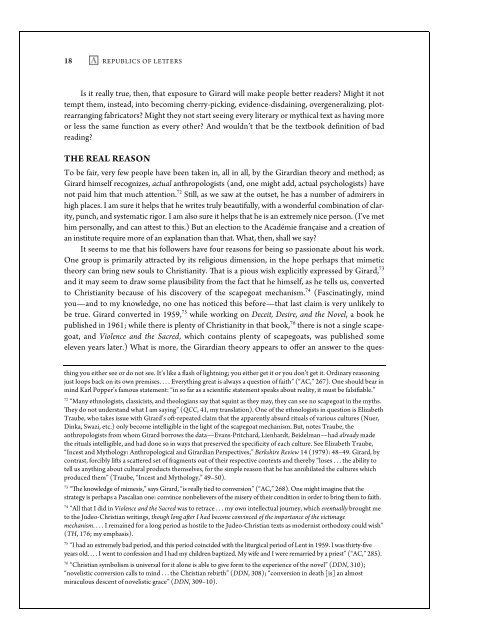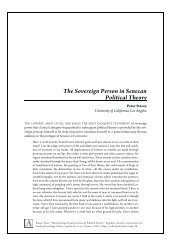Deceit, Desire, and the Literature Professor: Why Girardians Exist
Deceit, Desire, and the Literature Professor: Why Girardians Exist
Deceit, Desire, and the Literature Professor: Why Girardians Exist
You also want an ePaper? Increase the reach of your titles
YUMPU automatically turns print PDFs into web optimized ePapers that Google loves.
18 REPUBLICS OF LETTERS<br />
Is it really true, <strong>the</strong>n, that exposure to Girard will make people better readers? Might it not<br />
tempt <strong>the</strong>m, instead, into becoming cherry-picking, evidence-disdaining, overgeneralizing, plotrearranging<br />
fabricators? Might <strong>the</strong>y not start seeing every literary or mythical text as having more<br />
or less <strong>the</strong> same function as every o<strong>the</strong>r? And wouldn’t that be <strong>the</strong> textbook definition of bad<br />
reading?<br />
THE REAL REASON<br />
To be fair, very few people have been taken in, all in all, by <strong>the</strong> Girardian <strong>the</strong>ory <strong>and</strong> method; as<br />
Girard himself recognizes, actual anthropologists (<strong>and</strong>, one might add, actual psychologists) have<br />
not paid him that much attention. 72 Still, as we saw at <strong>the</strong> outset, he has a number of admirers in<br />
high places. I am sure it helps that he writes truly beautifully, with a wonderful combination of clarity,<br />
punch, <strong>and</strong> systematic rigor. I am also sure it helps that he is an extremely nice person. (I’ve met<br />
him personally, <strong>and</strong> can attest to this.) But an election to <strong>the</strong> Académie française <strong>and</strong> a creation of<br />
an institute require more of an explanation than that. What, <strong>the</strong>n, shall we say?<br />
It seems to me that his followers have four reasons for being so passionate about his work.<br />
One group is primarily attracted by its religious dimension, in <strong>the</strong> hope perhaps that mimetic<br />
<strong>the</strong>ory can bring new souls to Christianity. That is a pious wish explicitly expressed by Girard, 73<br />
<strong>and</strong> it may seem to draw some plausibility from <strong>the</strong> fact that he himself, as he tells us, converted<br />
to Christianity because of his discovery of <strong>the</strong> scapegoat mechanism. 74 (Fascinatingly, mind<br />
you—<strong>and</strong> to my knowledge, no one has noticed this before—that last claim is very unlikely to<br />
be true. Girard converted in 1959, 75 while working on <strong>Deceit</strong>, <strong>Desire</strong>, <strong>and</strong> <strong>the</strong> Novel, a book he<br />
published in 1961; while <strong>the</strong>re is plenty of Christianity in that book, 76 <strong>the</strong>re is not a single scapegoat,<br />
<strong>and</strong> Violence <strong>and</strong> <strong>the</strong> Sacred, which contains plenty of scapegoats, was published some<br />
eleven years later.) What is more, <strong>the</strong> Girardian <strong>the</strong>ory appears to offer an answer to <strong>the</strong> ques-<br />
thing you ei<strong>the</strong>r see or do not see. It’s like a flash of lightning; you ei<strong>the</strong>r get it or you don’t get it. Ordinary reasoning<br />
just loops back on its own premises. . . . Everything great is always a question of faith” (“AC,” 267). One should bear in<br />
mind Karl Popper’s famous statement: “in so far as a scientific statement speaks about reality, it must be falsifiable.”<br />
72 “Many ethnologists, classicists, <strong>and</strong> <strong>the</strong>ologians say that squint as <strong>the</strong>y may, <strong>the</strong>y can see no scapegoat in <strong>the</strong> myths.<br />
They do not underst<strong>and</strong> what I am saying” (QCC, 41, my translation). One of <strong>the</strong> ethnologists in question is Elizabeth<br />
Traube, who takes issue with Girard’s oft-repeated claim that <strong>the</strong> apparently absurd rituals of various cultures (Nuer,<br />
Dinka, Swazi, etc.) only become intelligible in <strong>the</strong> light of <strong>the</strong> scapegoat mechanism. But, notes Traube, <strong>the</strong><br />
anthropologists from whom Girard borrows <strong>the</strong> data—Evans-Pritchard, Lienhardt, Beidelman—had already made<br />
<strong>the</strong> rituals intelligible, <strong>and</strong> had done so in ways that preserved <strong>the</strong> specificity of each culture. See Elizabeth Traube,<br />
“Incest <strong>and</strong> Mythology: Anthropological <strong>and</strong> Girardian Perspectives,” Berkshire Review 14 (1979): 48–49. Girard, by<br />
contrast, forcibly lifts a scattered set of fragments out of <strong>the</strong>ir respective contexts <strong>and</strong> <strong>the</strong>reby “loses . . . <strong>the</strong> ability to<br />
tell us anything about cultural products <strong>the</strong>mselves, for <strong>the</strong> simple reason that he has annihilated <strong>the</strong> cultures which<br />
produced <strong>the</strong>m” (Traube, “Incest <strong>and</strong> Mythology,” 49–50).<br />
73 “The knowledge of mimesis,” says Girard, “is really tied to conversion” (“AC,” 268). One might imagine that <strong>the</strong><br />
strategy is perhaps a Pascalian one: convince nonbelievers of <strong>the</strong> misery of <strong>the</strong>ir condition in order to bring <strong>the</strong>m to faith.<br />
74 “All that I did in Violence <strong>and</strong> <strong>the</strong> Sacred was to retrace . . . my own intellectual journey, which eventually brought me<br />
to <strong>the</strong> Judeo-Christian writings, though long after I had become convinced of <strong>the</strong> importance of <strong>the</strong> victimage<br />
mechanism. . . . I remained for a long period as hostile to <strong>the</strong> Judeo-Christian texts as modernist orthodoxy could wish”<br />
(TH, 176; my emphasis).<br />
75 “I had an extremely bad period, <strong>and</strong> this period coincided with <strong>the</strong> liturgical period of Lent in 1959. I was thirty-five<br />
years old. . . . I went to confession <strong>and</strong> I had my children baptized. My wife <strong>and</strong> I were remarried by a priest” (“AC,” 285).<br />
76 “Christian symbolism is universal for it alone is able to give form to <strong>the</strong> experience of <strong>the</strong> novel” (DDN, 310);<br />
“novelistic conversion calls to mind . . . <strong>the</strong> Christian rebirth” (DDN, 308); “conversion in death [is] an almost<br />
miraculous descent of novelistic grace” (DDN, 309–10).



